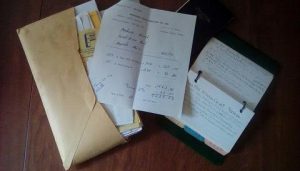 Recently, after completing – without hospitalization or arrest (for significant abuse of a power tool) a major painting project involving thirty-five exterior louvered house shutters attached to My Old House – many people asked me how old the vinyl shutters actually are, when they had first been put up (“gee, when were they last painted?”), and how did I know? Continue reading Diary of an old house
Recently, after completing – without hospitalization or arrest (for significant abuse of a power tool) a major painting project involving thirty-five exterior louvered house shutters attached to My Old House – many people asked me how old the vinyl shutters actually are, when they had first been put up (“gee, when were they last painted?”), and how did I know? Continue reading Diary of an old house
Tag Archives: Object Lessons
Frozen gold
 During a recent reorganization effort of my squirrel files, those slightly more organized companions to my squirrel bins, I came across newspaper clippings entitled “Frozen Gold.” The title probably caught my eye because of all the things I’ve found in My Old House, gold is not one of them (not even one measly coin).
During a recent reorganization effort of my squirrel files, those slightly more organized companions to my squirrel bins, I came across newspaper clippings entitled “Frozen Gold.” The title probably caught my eye because of all the things I’ve found in My Old House, gold is not one of them (not even one measly coin).
However, this frozen gold referred to ice blocks, those huge chunks necessary for the true “ice boxes” of early refrigeration days. Ice harvesting was once big industry on the Kennebec River in Maine, as I discovered by reading old newspaper clippings liberated from my files. Continue reading Frozen gold
‘My four children’
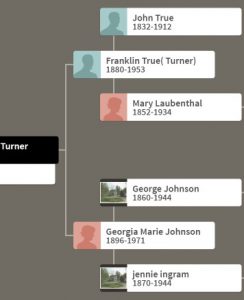 I have an entertaining update on my mysterious great-great-great-grandfather John A. Through alias True (1835–1912). In my recent post on this family, I discovered (with the help of DNA) his second later family, his slightly changed name, four additional children (a son John by each wife) – and wondered whether each of the four children he had by his two wives ever knew each other.
I have an entertaining update on my mysterious great-great-great-grandfather John A. Through alias True (1835–1912). In my recent post on this family, I discovered (with the help of DNA) his second later family, his slightly changed name, four additional children (a son John by each wife) – and wondered whether each of the four children he had by his two wives ever knew each other.
John A. True died at Fostoria, Ohio 14 January 1912 and in the index of Seneca County, Ohio Probate Records on Ancestry.com, I found that he did indeed leave a will. The year 1912 was just recent enough that I still had to write to the courthouse for copies, and I recently received John’s probate in the mail. Continue reading ‘My four children’
Boucher gleanings

Following up on my recent blog post about genealogical memory (“What do you know?”), I took a fresh look at some persistent brick walls in my mother’s family. The blog post – and a 5-generation fan chart template I got from two colleagues – led me to reflect on whether anything more could be gleaned about the background of my great-great-grandfather, William Boucher Jr. (1822–1899) of Baltimore, Maryland.
The answer, I’m happy to say, is “Yes”! Continue reading Boucher gleanings
A Starbuck in Seattle

This past June, I was excited to attend the first workshop ever offered by NEHGS in Seattle. It was a bit of a drive from my home in Salem, Oregon, but definitely worth it, and the most useful thing I learned was that many older Massachusetts deeds can be browsed free of charge through FamilySearch.org.
I’d hoped one day to revisit the Massachusetts island of Nantucket – where a branch of my family lived for the first two centuries of European settlement – largely to do additional investigation at their Registry of Deeds. The staff there was incredibly helpful when I visited in 2013, but even in the off-season, staying on the island is not exactly cheap, especially with a cross-country flight thrown in. Imagine my joy to discover that I could now do this work from home 24/7! Continue reading A Starbuck in Seattle
Fraternally yours
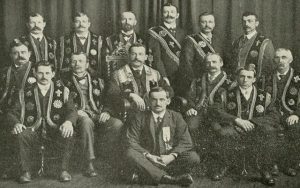 Fraternal organizations are not as commonplace for most people today as they were back in the mid-1800s on through the twentieth century. Our ancestors joined these groups for camaraderie, financial support regarding burials, insurance, and more. There were hundreds of such organizations, some of which popped up for just a brief few years. Continue reading Fraternally yours
Fraternal organizations are not as commonplace for most people today as they were back in the mid-1800s on through the twentieth century. Our ancestors joined these groups for camaraderie, financial support regarding burials, insurance, and more. There were hundreds of such organizations, some of which popped up for just a brief few years. Continue reading Fraternally yours
Getting the most out of a library visit
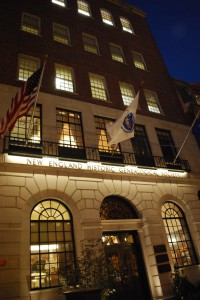 A few years ago, I was having dinner with some friends when I learned that one of them did not know what microfilm was. This conversation then turned to talking about why only some of us had heard of and used microfilm and others had never heard of it. As a new archivist (at the time), but a relatively seasoned researcher, I was shocked. It is conversations like that that remind me that not everyone knows why archives and libraries do the things that they do, which can seem intimidating. For someone visiting a repository for the first time, there are a few things that you should expect and can do ahead of time to maximize the amount of time you have available to look through material. Continue reading Getting the most out of a library visit
A few years ago, I was having dinner with some friends when I learned that one of them did not know what microfilm was. This conversation then turned to talking about why only some of us had heard of and used microfilm and others had never heard of it. As a new archivist (at the time), but a relatively seasoned researcher, I was shocked. It is conversations like that that remind me that not everyone knows why archives and libraries do the things that they do, which can seem intimidating. For someone visiting a repository for the first time, there are a few things that you should expect and can do ahead of time to maximize the amount of time you have available to look through material. Continue reading Getting the most out of a library visit
A knock at the door
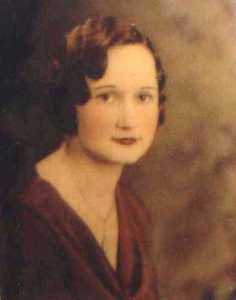
She was not pleased to see me – this paternal first cousin of my (biological) great-grandmother, Opal Young.[1] Her name was Grace,[2] and we had arranged our meeting through the mails, never having spoken to each other by telephone. Before, as I had stood on her stoop waiting for her to answer my knock, it was hard for me to believe that I would be meeting with a blood relative of my grandmother’s – one outside the small circle of my grandmother’s own descendants. I wondered how she might appear to me (part of me thought surely on a broomstick?) and I wondered what of “her family” she might recognize in me, too.
In some ways I am not sure why Grace agreed to see me at all. She was, after all, a 91-year-old spinster living alone in the hills above Glendale, California. While I had done my best to answer her many questions in advance, the prospect of meeting a strange relation at the door that day must have both daunted and intrigued her. Continue reading A knock at the door
Arranging your family papers, part 3
[Editor’s note: This series began here and continued here.]
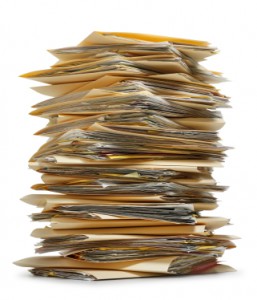 The last topic that I originally wanted to discuss in my article on organizing and preserving your family papers was digitization. For someone who wants to digitize their material there are a few things that you can do to have archival quality digital images.
The last topic that I originally wanted to discuss in my article on organizing and preserving your family papers was digitization. For someone who wants to digitize their material there are a few things that you can do to have archival quality digital images.
The first of thing to do is make sure that you have the necessary equipment for a digitization project. This would likely involve a flatbed scanner (your printer may have one) or a digital camera to photograph larger items. The disadvantage of using a camera is that if the item is large, you may not obtain a focused image and if you try to take the photograph by hand you may end up with a blurry picture. If you are photographing material, a tripod will help stabilize the camera. Continue reading Arranging your family papers, part 3
Arranging your family papers, part 2
[Editor’s note: This series began here.]
 When I begin organizing a collection, I start with a quick survey to help determine what types of material are in the collection. For me, this involves listing the formats in the collection, identifying the creators (if it is a collection of family papers), and the general years of the material. I also make note of any torn/damaged records, as I prefer to know about them before I start moving things around and possibly separate the pieces or completely tearing an item that only had a small tear because it snags on something. Continue reading Arranging your family papers, part 2
When I begin organizing a collection, I start with a quick survey to help determine what types of material are in the collection. For me, this involves listing the formats in the collection, identifying the creators (if it is a collection of family papers), and the general years of the material. I also make note of any torn/damaged records, as I prefer to know about them before I start moving things around and possibly separate the pieces or completely tearing an item that only had a small tear because it snags on something. Continue reading Arranging your family papers, part 2